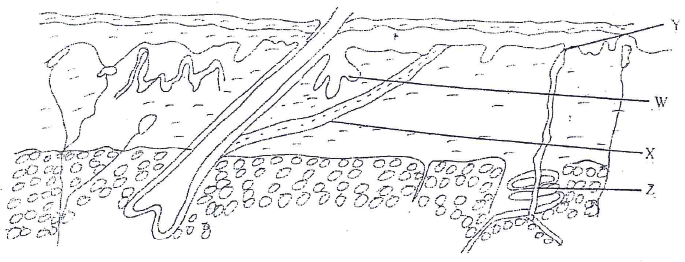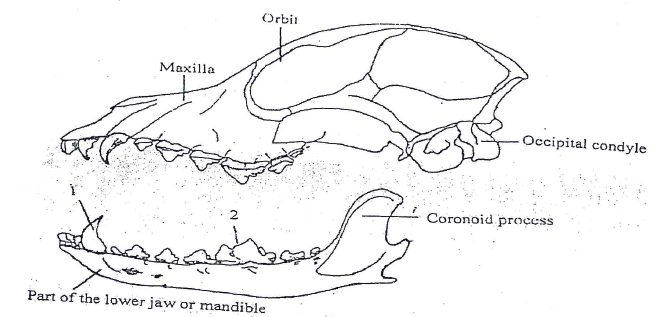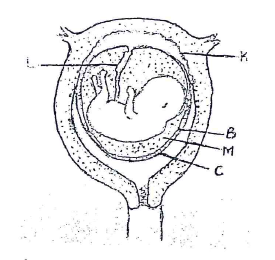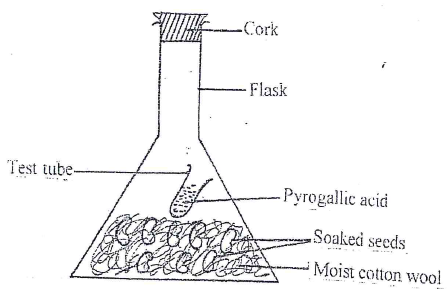Click the link below to download as a full set with all the subjects. (PDF)
https://downloads.easyelimu.com/details/35-Alliance_High_School_Pre_Trial_Examination
232/2
BIOLOGY
PAPER 2
THEORY
MAY 2018
2 HOURS
ALLIANCE HIGH SCHOOL
PRE-TRIAL EXAMS
INSTRUCTIONS TO CANDIDATES
- This paper consists of section A and B.
- Answer ALL the questions in section A in the speces provided.
- In section B, answer question 6 (compulsory) and either question 7 or 8 in the spaces provided
SECTION A
- A woman whose blood group is O gives birth to a son whose blood group is A and a daughter whose blood group is B.
-
- State the possible genotype of the father. (1 mk)
- Using a punnet square, work out the genotypes of the offsprings. (3 mks)
-
- If the mother is rhesus positive and the father is rhesus negative, what conditions is the child likely to develop. (1 mk)
- How can the condition be controlled? (1 mk)
- Explain why the second born child is at risk of death that the first born child if no precaution is taken. (2 mks)
-
- The diagram below shows a section through the mammalian skin.

- Name the parts labelled W and X. (2 mks)
- State the function of the parts labelled Y and Z. (2 mks)
- Explain the changes that occur in the skin when it is cold. (4 mks)
- The figure below shows the skull and dentition in a certain mammal. Study it and answer the questions that follow.

- Write down the dental formula of the mammal shown above. (1 mk)
-
- Identify the mode of feeding of the above mammal. (1 mk)
- give reasons for your answer in b(i) above. (2 mks)
- State the adaptations and functions of the teeth numbered 1 and 2. (4 mks)
- The diagram below is an illustration of the relationship between a developing foetus and the maternal tissues. Study it and answer the questions that follow.

- Name the structures labelled B, L and C (3 mks)
- State one function of the fluid found in part M. (1 mk)
- Name two substances that pass from the foetus to the mother. (2 mks)
-
- Name the hormone produced by the part labelled K in the fourch month of gestation and is reponsible for maintaining a highly vascularized endometrium. (1 mk)
- Which hormone controls the contraction of the uterus wall during parturition? (1 mk)
- The following experiment was set up to investigate a certain aspect. The set up was left at room temperature for 5 days.

- What was the aim of the experiment? (1 mk)
- What observation was made? (1 mk)
- Explain the above observation. (2 mks)
- How can a control be set up? (2 mks)
- Draw a well labelled diagram of an opened bean seed to show the inner structures. (2 mks)
SECTION B
- The data below shows the change in average height and dry mass of the stem of an animal leguminous plant. The data was taken between the 1st and 14th week after planting.
Week Height(cm) Mass(g) 1 6 7 2 16 18 3 31 37 4 48 60 5 61 94 6 71 145 7 79 190 8 86 225 9 91 250 10 94 270 11 96 285 12 96 305 13 96 305 14 96 285 - Plot the graphs of height and mass against time on the same axis. (7 mks)
- During which two weeks did the largest increase in mass occur? (1 mk)
- Calculate the average growth rate (in g) during the two weeks you have mentioned in (b) above. (2 mks)
- Between 11th and 13th week, average height of the plants remained the same but mass increased. Suggest an explanation for this observation. (2 mks)
- Suggest an explanation to account for the decrease in mass after the 13th week. (1 mk)
- Why is it necessary to use dry mass instead of fresh mass? (2 mks)
- Why was it necessary to carry out both dry mass and height measurements? (1 mk)
- Explain how you can measure the growth of one leaf. (4 mks)
-
- A dicotyledonous stem offers support to the plant. Give three necessities for this support. (3 mks)
- Describe the adaptation of the stem of a dicotyledonous plant to its function. (17 mks)
- Describe the characteristics and functions of the three types of muscles found in the mammalian body. (20 mks)
Download Biology Paper 2 - Alliance High School Pre-Trial Examination 2018.
Tap Here to Download for 50/-
Get on WhatsApp for 50/-
Why download?
- ✔ To read offline at any time.
- ✔ To Print at your convenience
- ✔ Share Easily with Friends / Students

